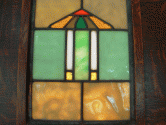Finding Affordable Arts & Crafts Stained Glass

Odds are none of us is ever going to have either in our modest homes.
But stained glass windows give Arts & Crafts collectors a wonderful opportunity to bring splashes of color into rooms often dominated by shades of brown. While they don’t provide the privacy you sometimes need in rooms facing your nearby neighbors – and for that you can turn to new Arts & Crafts curtains – they can work in a number of situations: hanging from a beam in a vaulted ceiling, set inside the framework to a skylight, suspended as a divider between two rooms, hung inside a screened-in porch, framed in front of a light box in a windowless basement room, built into a custom exterior door, hung across the top of a picture window or replacing a hinged transom window over a bedroom door.
When I go shopping for stained glass windows, I don’t typically start with traditional antiques shops. Instead, I track down architectural salvage warehouses, where I’m more apt to find a hundred or more windows in a variety of sizes, shapes, styles and conditions. Some will have come from local demolitions, but with those demolitions fortunately on the decline, a growing number are regularly imported from Europe.
And if you are willing to do a little work to the frame – pulling old nails, filling screw holes, refinishing or repainting the wood – you can find them at bargain prices.
Personally, I’m not bothered by a cracked pane or two, but I have stopped buying windows with missing pieces of glass. I once took a stained glass class, thinking I could then cut and replace missing pieces, but what I learned is that it takes more than just a half-dozen night classes to learn how to properly dismantle and reassemble a stained glass window.
I also learned the hard way that removing an unwanted original window frame from around a stained glass window is not as simple as tapping the four boards apart with a mallet. In nearly every instance, multiple layers of paint had glued the outer lead channel to the wood. Instead of separating the lead channel from the wood, I separated the lead channel from the glass. Not a good idea.
If you have to remove the original wood window from around the glass, the only way I have found you can do so is by carefully cutting away the wood. The safest way is with a handsaw, but if you are experienced with a power saw and don’t mind ruining an old blade, you can make several passes – staying away from the glass – until you can then pry the last strip of wood away with your fingers.
Warning: Wear safety glasses and don’t have anyone in the room watching you. Small finish nails and broken screws buried in the wood beneath a layer of paint become flying pieces of shrapnel when hit with a whirling steel saw blade.
When cleaning paint splatters and grime off an old stained glass window, don’t assume – as many have – that steel wool, chisels or even razor blades won’t scratch glass. They will. Instead, use a glass cleaner and give it time to penetrate the paint and grime so that you can remove it using nothing more dangerous than a dishwashing pad.
Finally, if you don’t have the time or energy to scavenge for salvaged stained glass, don’t forget about the talented stained glass artists who work in the Arts & Crafts style, especially when it comes to making a particular design fit a specific opening.
Good Luck!
– Bruce Johnson
Photographs: These are closeups of stained glass that came from the front of a player piano and turned up in an antiques shop.

